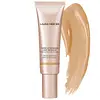Laura Mercier Tinted Moisturizer Light Revealer Natural Skin Illuminator SPF 25 PA+++ Versus Too Faced Born This Way Undetectable Medium-To-Full Coverage Foundation
What's inside
What's inside
 Key Ingredients
Key Ingredients

 Benefits
Benefits

 Concerns
Concerns

 Ingredients Side-by-side
Ingredients Side-by-side

Butyl Methoxydibenzoylmethane 3%
UV AbsorberHomosalate 5%
Skin ConditioningEthylhexyl Salicylate 5%
UV AbsorberOctocrylene 3%
UV AbsorberWater
Skin ConditioningButyloctyl Salicylate
Skin ConditioningButylene Glycol
HumectantOctyldodecyl Neopentanoate
EmollientDimethicone
EmollientGlyceryl Stearate
EmollientPEG-100 Stearate
Glycerin
HumectantAscophyllum Nodosum Extract
Skin ConditioningSilica
AbrasiveEthylhexylglycerin
Skin ConditioningCetearyl Alcohol
EmollientCoco-Glucoside
CleansingCitric Acid
BufferingBatyl Alcohol
EmollientBis-PEG/PPG-14/14 Dimethicone
EmollientAcrylates/C10-30 Alkyl Acrylate Crosspolymer
Emulsion StabilisingDisodium EDTA
Potassium Hydroxide
BufferingTocopheryl Acetate
AntioxidantTetrahexyldecyl Ascorbate
AntioxidantXanthan Gum
EmulsifyingSaccharide Isomerate
HumectantSodium Citrate
BufferingTin Oxide
AbrasivePhenoxyethanol
PreservativePotassium Sorbate
PreservativeIron Oxides
Mica
Cosmetic ColorantTitanium Dioxide
Cosmetic ColorantButyl Methoxydibenzoylmethane 3%, Homosalate 5%, Ethylhexyl Salicylate 5%, Octocrylene 3%, Water, Butyloctyl Salicylate, Butylene Glycol, Octyldodecyl Neopentanoate, Dimethicone, Glyceryl Stearate, PEG-100 Stearate, Glycerin, Ascophyllum Nodosum Extract, Silica, Ethylhexylglycerin, Cetearyl Alcohol, Coco-Glucoside, Citric Acid, Batyl Alcohol, Bis-PEG/PPG-14/14 Dimethicone, Acrylates/C10-30 Alkyl Acrylate Crosspolymer, Disodium EDTA, Potassium Hydroxide, Tocopheryl Acetate, Tetrahexyldecyl Ascorbate, Xanthan Gum, Saccharide Isomerate, Sodium Citrate, Tin Oxide, Phenoxyethanol, Potassium Sorbate, Iron Oxides, Mica, Titanium Dioxide
Water
Skin ConditioningDimethicone
EmollientCoco-Caprylate/Caprate
EmollientTrimethylsiloxysilicate
EmollientPhenyl Trimethicone
Skin ConditioningCetyl PEG/PPG-10/1 Dimethicone
EmulsifyingPropanediol
SolventPolyglyceryl-4 Isostearate
EmulsifyingGlycerin
HumectantMica
Cosmetic ColorantSodium Hyaluronate
HumectantRhododendron Ferrugineum Extract
MaskingCocos Nucifera Fruit Juice
EmollientTocopheryl Acetate
AntioxidantCaprylyl Glycol
EmollientMethicone
EmollientCocos Nucifera Oil
MaskingDisteardimonium Hectorite
StabilisingSodium Chloride
Masking1,2-Hexanediol
Skin ConditioningTrisodium Ethylenediamine Disuccinate
Sodium Dehydroacetate
PreservativeSodium Benzoate
MaskingPotassium Sorbate
PreservativeCI 77891
Cosmetic ColorantCI 77491
Cosmetic ColorantCI 77492
Cosmetic ColorantCI 77499
Cosmetic ColorantWater, Dimethicone, Coco-Caprylate/Caprate, Trimethylsiloxysilicate, Phenyl Trimethicone, Cetyl PEG/PPG-10/1 Dimethicone, Propanediol, Polyglyceryl-4 Isostearate, Glycerin, Mica, Sodium Hyaluronate, Rhododendron Ferrugineum Extract, Cocos Nucifera Fruit Juice, Tocopheryl Acetate, Caprylyl Glycol, Methicone, Cocos Nucifera Oil, Disteardimonium Hectorite, Sodium Chloride, 1,2-Hexanediol, Trisodium Ethylenediamine Disuccinate, Sodium Dehydroacetate, Sodium Benzoate, Potassium Sorbate, CI 77891, CI 77491, CI 77492, CI 77499
Ingredients Explained
These ingredients are found in both products.
Ingredients higher up in an ingredient list are typically present in a larger amount.
Dimethicone is a type of synthetic silicone created from natural materials such as quartz.
What it does:
Dimethicone comes in different viscosities:
Depending on the viscosity, dimethicone has different properties.
Ingredients lists don't always show which type is used, so we recommend reaching out to the brand if you have questions about the viscosity.
This ingredient is unlikely to cause irritation because it does not get absorbed into skin. However, people with silicone allergies should be careful about using this ingredient.
Note: Dimethicone may contribute to pilling. This is because it is not oil or water soluble, so pilling may occur when layered with products. When mixed with heavy oils in a formula, the outcome is also quite greasy.
Learn more about DimethiconeGlycerin is already naturally found in your skin. It helps moisturize and protect your skin.
A study from 2016 found glycerin to be more effective as a humectant than AHAs and hyaluronic acid.
As a humectant, it helps the skin stay hydrated by pulling moisture to your skin. The low molecular weight of glycerin allows it to pull moisture into the deeper layers of your skin.
Hydrated skin improves your skin barrier; Your skin barrier helps protect against irritants and bacteria.
Glycerin has also been found to have antimicrobial and antiviral properties. Due to these properties, glycerin is often used in wound and burn treatments.
In cosmetics, glycerin is usually derived from plants such as soybean or palm. However, it can also be sourced from animals, such as tallow or animal fat.
This ingredient is organic, colorless, odorless, and non-toxic.
Glycerin is the name for this ingredient in American English. British English uses Glycerol/Glycerine.
Learn more about GlycerinMica is a naturally occurring mineral used to add shimmer and color in cosmetics. It can also help improve the texture of a product or give it an opaque, white/silver color.
Serecite is the name for very fine but ragged grains of mica.
This ingredient is often coated with metal oxides like titanium dioxide. Trace amounts of heavy metals may be found in mica, but these metals are not harmful in our personal products.
Mica has been used since prehistoric times throughout the world. Ancient Egyptian, Indian, Greek, Roman, Aztec, and Chinese civilizations have used mica.
Learn more about MicaPotassium Sorbate is a preservative used to prevent yeast and mold in products. It is commonly found in both cosmetic and food products.
This ingredient comes from potassium salt derived from sorbic acid. Sorbic acid is a natural antibiotic and effective against fungus.
Both potassium sorbate and sorbic acid can be found in baked goods, cheeses, dried meats, dried fruit, ice cream, pickles, wine, yogurt, and more.
You'll often find this ingredient used with other preservatives.
Learn more about Potassium SorbateTocopheryl Acetate is AKA Vitamin E. It is an antioxidant and protects your skin from free radicals. Free radicals damage the skin by breaking down collagen.
One study found using Tocopheryl Acetate with Vitamin C decreased the number of sunburned cells.
Tocopheryl Acetate is commonly found in both skincare and dietary supplements.
Learn more about Tocopheryl AcetateWater. It's the most common cosmetic ingredient of all. You'll usually see it at the top of ingredient lists, meaning that it makes up the largest part of the product.
So why is it so popular? Water most often acts as a solvent - this means that it helps dissolve other ingredients into the formulation.
You'll also recognize water as that liquid we all need to stay alive. If you see this, drink a glass of water. Stay hydrated!
Learn more about Water